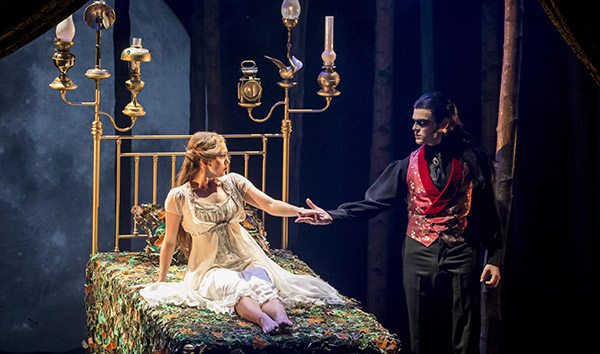Gothic architecture is characterized by its soaring verticality, pointed arches, flying buttresses, and elaborate stone carvings. Bringing out these features in night settings requires more than just brightness—it demands finesse, precision, and warmth. The key to this kind of architectural lighting lies in the use of uplighting with the right tools. In this article, we explore how to achieve dramatic, reverent illumination using modern LED fixtures, particularly the 7x60W Bee Eye Moving Head and the 60W Warm White Par Light.
Highlighting the Vertical Drama
Gothic structures like cathedrals, chapels, and civic buildings were designed to draw the eye upward. This architectural intent should be echoed in lighting design. Uplighting serves as a modern counterpart to Gothic upward thrust, projecting beams from the ground toward intricate cornices, ribbed vaults, and spires.
The 60W Warm White Par Light is ideal for this purpose. Its COB LED engine delivers a broad, uniform wash that gently reveals the stonework without overwhelming it. When placed near the base of buttresses or under arches, it creates an ethereal glow that enhances the building’s spiritual atmosphere.
_BzjLDs.jpg)
Precision Meets Texture: The Moving Head Advantage
While static uplighting provides base illumination, dynamic fixtures add texture, variation, and movement to the scene. The 7x60W Bee Eye Moving Head stands out for this role. Its rotating zoom head and narrow-to-wide beam control allow lighting designers to highlight selective features of Gothic architecture—perhaps a tympanum one moment, a rose window the next.
This fixture excels not just in power and precision, but in its flexibility. You can program subtle motion sequences to slowly shift light focus across stone tracery, or use its ring-style beam matrix to simulate candle flickers against the wall—an homage to the historical lighting of medieval churches.
_hvnhlp.jpg)
Blending Warmth and Shadow
Harsh light flattens detail and robs Gothic design of its dimensionality. The 60W Warm White Par Light counters this by providing a tungsten-like warmth that harmonizes with natural stone. Placed strategically beneath columns or staircases, these fixtures preserve shadow-play—an essential component of Gothic mystique.
Lighting designers often prefer to use these fixtures at angles between 15 to 35 degrees off-vertical. This method sculpts depth into facade elements like gargoyles, capitals, and recessed portals, enriching the nighttime experience.
Layering Zones with Pixel Mapping
For larger cathedrals and castles, dividing the architecture into lighting zones enhances spatial understanding. Here, the 7x60W Bee Eye Moving Head's pixel control becomes invaluable. Each of the seven LED modules is independently controllable, allowing you to assign specific hues or brightness to different parts of the building in one fixture.
For example, you can keep the tower’s base in subtle amber while bathing the upper turret in cool lavender. Such zoning techniques modernize traditional lighting without undermining the solemnity of Gothic design.
Cable-Free Elegance in Heritage Sites
Working with protected Gothic structures often means restricted access to power runs and mounting positions. The 7x60W Bee Eye Moving Head comes in a waterproof, magnesium-alloy housing, allowing discreet outdoor placement even on grass, stone, or gravel. It’s IP-rated for rain and dust, making it reliable for long-term outdoor installations without drilling into walls.
Pairing it with the 60W Warm White Par Light, which is also compact and unobtrusive, results in a refined lighting system that doesn't interfere with public access, weddings, or cultural events.
Case Study: Courtyard Illumination of a Gothic Abbey
In one recent installation at a restored 14th-century abbey, designers used a mix of 12 60W Warm White Par Lights to floodlight stone corridors, door arches, and stained-glass window recesses. Complementing this were eight 7x60W Bee Eye Moving Head fixtures programmed to cycle through a slow fade of warm hues that gently danced across the vaulted ceiling.
The result was not just illumination—it was storytelling. Visitors commented on how the lighting captured the quiet grandeur of the abbey and made them feel part of something sacred.
Dynamic Highlights for Event Flexibility
Many Gothic churches and castles now host seasonal events: concerts, historic reenactments, or open-air theater. Lighting must therefore be adaptable. The 7x60W Bee Eye Moving Head shines again in these contexts—capable of DMX integration, color mixing, and beam animation. You can go from a stately warm wash during a wedding to rich crimson pulses for a dramatic performance, all without changing fixtures.
The 60W Warm White Par Light, on the other hand, remains constant as a trusted source of gentle ambiance. Its quiet operation and flicker-free dimming make it equally effective during live video recordings.

Practical Setup Tips
Use uplights close to the wall to minimize light spill and define column depth.
Elevate moving heads on low risers to avoid harsh foot-level glare.
Experiment with warm-cool layering by mixing both product types for depth.
Map zones vertically—foundation, mid-wall, cornice—to maintain architectural logic.
Both the 7x60W Bee Eye Moving Head and the 60W Warm White Par Light are exceptionally suited to this structured approach.
Lasting Impact Through Lighting
Gothic architecture was meant to awe, inspire, and elevate. With thoughtful lighting using high-precision tools like the 7x60W Bee Eye Moving Head and the 60W Warm White Par Light, we can extend that sense of majesty into the night.
These lighting instruments don’t merely brighten—they converse with the building’s form, allowing history and artistry to resound with contemporary clarity.
READ MORE:





Blue Sea Lighting is an enterprise with rich experience in the integration of industry and trade in stage lighting and stage special effects related equipment. Its products include moving head lights, par lights, wall washer lights, logo gobo projector lights, power distributor, stage effects such as electronic fireworks machines, snow machines, smoke bubble machines, and related accessories such as light clamps.
Quick Links
For more questions subscribe to our email








